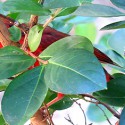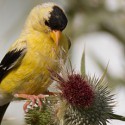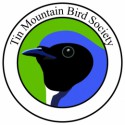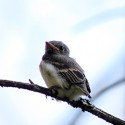 Photo ©
Keith Williams
Photo ©
Keith Williams

Do Bird-Friendly Yards Attract Predators?
As more bird enthusiasts replace their lawns with bird-friendly plantings like trees and shrubs, they might be concerned about attracting nest predators into the area. Though nest boxes can be equipped with predator guards, most open cup nests, like those of Northern Cardinals and American Robins, cannot be.
Researchers from The Ohio State University and the Cornell Lab of Ornithology investigated whether there was a link between woody vegetation (i.e., trees and shrubs) and predator activity by conducting a study in several Ohio neighborhoods. The researchers surveyed for common nest predators in backyards, and looked for a relationship to the amount of woody vegetation. Common nest predators at the studied sites in Ohio included Eastern gray squirrel, Common Grackle, Brown-headed Cowbird, Blue Jay, and domestic cat (among others).
What they found was unexpected. Even though many nest predators use woody vegetation, bird-friendly landscaping did not attract predators. Yards and neighborhoods with more mature trees and shrubs were no more likely to have high predator activity than yards without. Their findings suggest that increasing the amount of shrubbery and trees in suburban yards does not encourage increased activity of nest predators. So with that in mind, feel free to check out our tips for landscaping for nesting birds.
Reference: Malpass, J.S., Rodewald, A.D., and Matthews, S.N. 2015. Woody cover does not promote activity of nest predators in residential yards. Landscape and Urban Planning 135: 32-39.

Go For The Gold
Spring is right around the corner! And speaking of bird-friendly gardening, did you know you can attract more goldfinches to nest in your yard with the right plants? We shared our tips for growing a goldfinch-friendly habitat (complete with nesting materials, and one plant to avoid) with Birds & Blooms Magazine. Read the article now, and get ready for growing season. And for a little more spring training, read all about the nesting habits of American Goldfinch and Lesser Goldfinch on our website. Don’t you feel warmer already?

Welcome Tin Mountain Bird Society
Tin Mountain Bird Society has recently joined the family of NestWatch Chapters. Based out of the Tin Mountain Conservation Center in Albany, New Hampshire, the Society’s mission is to provide meaningful experiences for birders and enlist support for bird conservation efforts in the White Mountains region. One of the main goals of the society is to support local and regional bird study efforts.
To launch their involvement with NestWatch they will be installing 120 nest boxes this spring. Tin Mountain will also be providing hands-on training and nest monitoring opportunities, as well as involving its membership in other bird-related citizen-science projects. If you would like to get involved in the Society, visit their website to learn more.

Time To Leave The Nest
For the past six months, NestWatch has benefited immeasurably from the help of our intern, Melcolm Crutchfield. But all good things must come to an end, and it’s time for Melcolm to leave the nest. He has accepted a position with Americorps in Arizona. Please join us in thanking Melcolm for all of his hard work, and wishing him much success in his future endeavors.